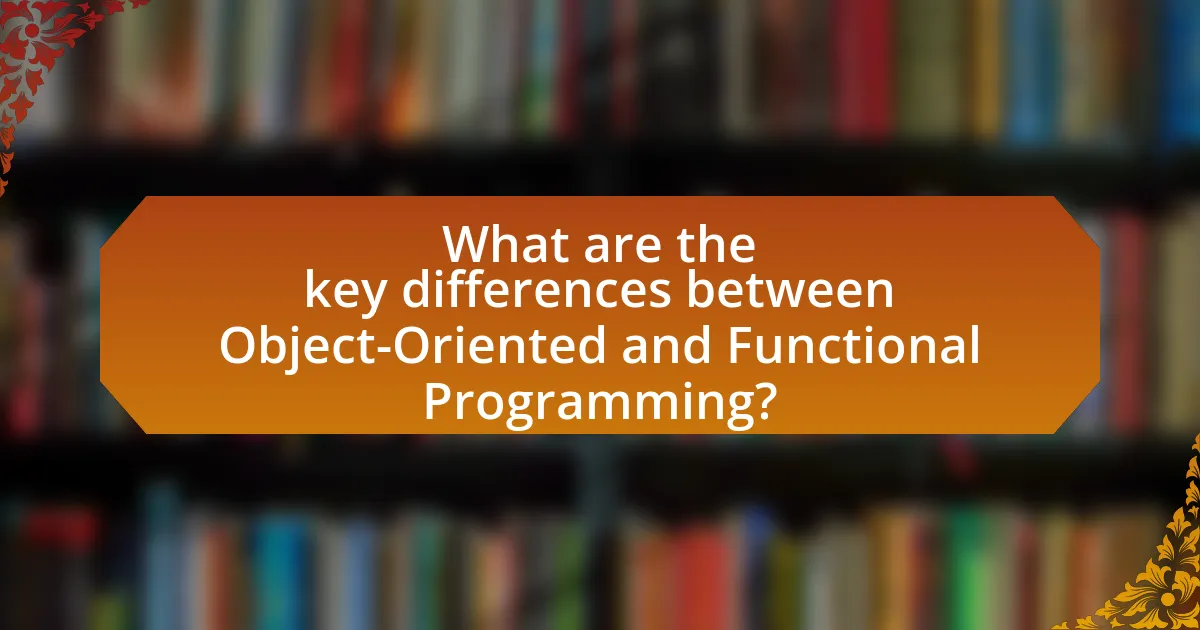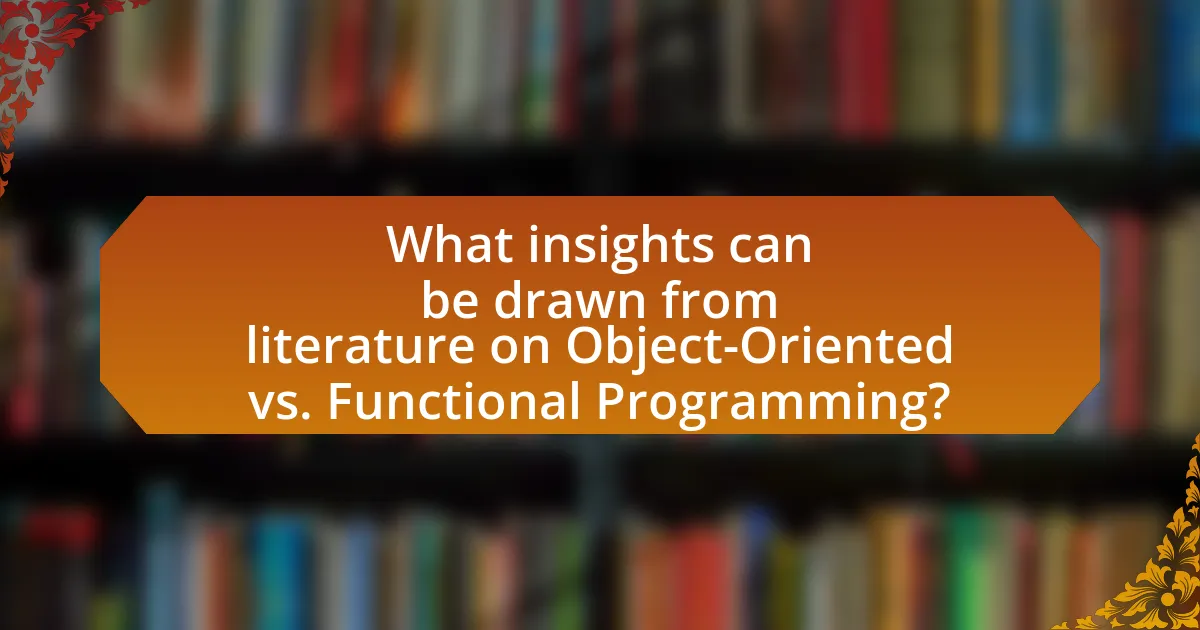The article provides a comparative study of Object-Oriented Programming (OOP) and Functional Programming (FP) languages, highlighting their distinct paradigms, principles, and historical contexts. It examines how OOP organizes code around objects, emphasizing encapsulation, inheritance, and polymorphism, while FP focuses on functions, immutability, and higher-order functions. Key differences in data handling, code reusability, performance implications, and common use cases for each paradigm are discussed, along with insights from academic literature on their effectiveness and emerging trends in the industry. The article concludes with practical recommendations for developers on choosing between these paradigms based on project requirements.

What are Object-Oriented and Functional Programming Languages?
Object-oriented programming (OOP) languages are designed around the concept of objects, which can encapsulate data and behavior, allowing for modularity and code reuse. Examples of OOP languages include Java, C++, and Python, which utilize classes and inheritance to promote organized code structures. In contrast, functional programming languages focus on the evaluation of functions and immutability, emphasizing the use of pure functions and avoiding side effects. Languages such as Haskell, Lisp, and Scala exemplify this paradigm, enabling developers to write concise and predictable code through higher-order functions and first-class functions. The distinction between these two programming paradigms lies in their approach to data and behavior management, with OOP prioritizing state and behavior encapsulation, while functional programming emphasizes function application and data transformation.
How do Object-Oriented Programming Languages function?
Object-Oriented Programming (OOP) languages function by organizing software design around data, or objects, rather than functions and logic. In OOP, objects are instances of classes, which define the properties (attributes) and behaviors (methods) that the objects can have. This paradigm promotes encapsulation, inheritance, and polymorphism, allowing for code reusability and modularity. For instance, encapsulation restricts access to certain components of an object, inheritance enables new classes to inherit attributes and methods from existing classes, and polymorphism allows methods to do different things based on the object that it is acting upon. These principles facilitate easier maintenance and scalability of software systems, as evidenced by the widespread use of OOP languages like Java and C++ in large-scale applications.
What are the key principles of Object-Oriented Programming?
The key principles of Object-Oriented Programming (OOP) are encapsulation, inheritance, polymorphism, and abstraction. Encapsulation involves bundling data and methods that operate on that data within a single unit, typically a class, which restricts direct access to some of the object’s components. Inheritance allows a new class to inherit properties and behaviors from an existing class, promoting code reusability. Polymorphism enables objects to be treated as instances of their parent class, allowing for method overriding and dynamic method resolution. Abstraction simplifies complex systems by exposing only the necessary parts while hiding the implementation details. These principles are foundational in OOP, as they facilitate modularity, code maintenance, and scalability in software development.
How do Object-Oriented languages manage data and behavior?
Object-Oriented languages manage data and behavior through the use of objects, which encapsulate both state (data) and behavior (methods). In these languages, data is represented as attributes within objects, while behavior is defined by functions or methods that operate on that data. This encapsulation allows for data hiding and abstraction, enabling developers to create modular and reusable code. For example, in languages like Java and C++, classes serve as blueprints for creating objects, allowing for inheritance and polymorphism, which further enhance the management of data and behavior by enabling code reuse and dynamic method resolution. This structure is foundational in Object-Oriented Programming, as it promotes a clear organization of code and facilitates easier maintenance and scalability.
What defines Functional Programming Languages?
Functional programming languages are defined by their emphasis on the use of functions as the primary building blocks for constructing programs. These languages prioritize immutability, first-class functions, and higher-order functions, allowing functions to be passed as arguments, returned from other functions, and assigned to variables. For example, languages like Haskell and Lisp exemplify these characteristics, enabling developers to write code that is more declarative and less reliant on mutable state. This functional paradigm leads to clearer reasoning about code behavior and facilitates easier debugging and testing, as functions are typically pure and free from side effects.
What are the core concepts of Functional Programming?
The core concepts of Functional Programming include first-class functions, pure functions, immutability, higher-order functions, and function composition. First-class functions treat functions as first-class citizens, allowing them to be passed as arguments, returned from other functions, and assigned to variables. Pure functions produce the same output for the same input without side effects, enhancing predictability and testability. Immutability ensures that data cannot be modified after creation, promoting safer and more reliable code. Higher-order functions can take other functions as parameters or return them, enabling more abstract and flexible programming patterns. Function composition allows the combination of simple functions to build more complex operations, facilitating modular and reusable code. These concepts collectively contribute to the declarative nature of Functional Programming, distinguishing it from imperative paradigms.
How do Functional languages handle state and side effects?
Functional languages handle state and side effects primarily through immutability and pure functions. In functional programming, data is treated as immutable, meaning that once a value is assigned, it cannot be changed. This approach minimizes side effects, as functions do not alter the state of the program or rely on external states. Instead, they return new values based on their inputs, ensuring predictability and easier reasoning about code behavior.
For example, languages like Haskell enforce purity by design, where functions are expected to have no side effects, and any state changes are managed through constructs like monads. Monads encapsulate side effects, allowing developers to sequence operations while maintaining functional purity. This methodology is supported by research, such as “Functional Programming in Haskell” by Michael Thompson, which illustrates how functional languages effectively manage state and side effects through these principles.
What are the historical contexts of Object-Oriented and Functional Programming?
Object-Oriented Programming (OOP) emerged in the 1960s, primarily through the work of Alan Kay, who developed the Smalltalk language, emphasizing encapsulation and message passing. This paradigm gained traction in the 1980s with the rise of languages like C++ and Java, which incorporated OOP principles, allowing for more modular and reusable code structures.
Functional Programming (FP) has its roots in the 1930s with Alonzo Church’s lambda calculus, which laid the theoretical groundwork for functional languages. The 1970s saw the development of languages like Lisp and ML, which introduced first-class functions and recursion as core concepts. FP gained renewed interest in the 2000s with the advent of languages like Haskell and Scala, promoting immutability and higher-order functions.
The historical contexts of OOP and FP illustrate their evolution from theoretical foundations to practical applications, reflecting shifts in programming paradigms that address different software development challenges.
How did Object-Oriented Programming evolve over time?
Object-Oriented Programming (OOP) evolved significantly from its inception in the 1960s to the present day. Initially, OOP emerged with the development of Simula, a language designed for simulations that introduced concepts like classes and objects. In the 1970s, Smalltalk further advanced OOP by emphasizing message passing and dynamic typing, which laid the groundwork for modern OOP principles. The 1980s saw the introduction of C++ by Bjarne Stroustrup, which combined OOP with the efficiency of C, popularizing OOP in systems programming. The 1990s and 2000s witnessed the rise of languages like Java and Python, which made OOP more accessible and integrated it into web development and enterprise applications. Today, OOP continues to evolve with the incorporation of functional programming features, reflecting a trend towards multi-paradigm programming languages that enhance flexibility and code reuse.
What historical milestones shaped Functional Programming?
The historical milestones that shaped Functional Programming include the development of the lambda calculus by Alonzo Church in the 1930s, which provided a formal foundation for functional languages. In the 1950s, John McCarthy introduced LISP, the first functional programming language, which emphasized recursion and symbolic computation. The 1970s saw the emergence of ML, which introduced type inference and pattern matching, further influencing functional programming paradigms. In the 1980s, the introduction of Haskell, a standardized functional programming language, solidified the principles of lazy evaluation and strong static typing. These milestones collectively established the theoretical and practical frameworks that define modern functional programming.

What are the key differences between Object-Oriented and Functional Programming?
Object-Oriented Programming (OOP) and Functional Programming (FP) differ primarily in their approach to data and behavior. OOP organizes code around objects that encapsulate data and methods, promoting concepts like inheritance and polymorphism, which facilitate code reuse and modularity. In contrast, FP emphasizes the use of pure functions and immutable data, focusing on the evaluation of expressions rather than the execution of commands, which leads to easier reasoning about code and fewer side effects.
OOP relies on state and mutable objects, which can lead to complex interactions and dependencies, while FP avoids state changes, resulting in more predictable and testable code. For example, languages like Java and C++ exemplify OOP principles, whereas languages like Haskell and Scala showcase FP characteristics. The choice between these paradigms often depends on the specific requirements of a project, such as the need for scalability or ease of debugging.
How do the paradigms differ in terms of structure?
Object-oriented programming (OOP) and functional programming (FP) paradigms differ significantly in their structural organization. OOP structures code around objects, which encapsulate data and behavior, promoting modularity and reusability through inheritance and polymorphism. In contrast, FP structures code around functions and immutable data, emphasizing the application of functions to arguments and the use of higher-order functions, which allows for a more declarative style of programming. This distinction is evident in how OOP utilizes classes and objects to model real-world entities, while FP focuses on the composition of pure functions to achieve results without side effects.
What are the distinctions in data handling between the two paradigms?
Object-oriented programming (OOP) and functional programming (FP) handle data distinctly, with OOP focusing on encapsulation and state management, while FP emphasizes immutability and first-class functions. In OOP, data is bundled with methods within objects, allowing for state changes and interactions through methods, which can lead to side effects. In contrast, FP treats data as immutable, promoting pure functions that do not alter the input data, thereby minimizing side effects and enhancing predictability. This fundamental difference in data handling influences how developers approach problem-solving, with OOP often favoring a more stateful, interactive model, while FP encourages a stateless, declarative style.
How do Object-Oriented and Functional languages approach code reusability?
Object-Oriented languages approach code reusability through encapsulation, inheritance, and polymorphism, allowing developers to create modular and reusable components. For instance, classes can inherit properties and methods from parent classes, enabling code reuse without duplication. In contrast, Functional languages emphasize code reusability through higher-order functions and immutability, allowing functions to be passed as arguments or returned as values, which promotes the creation of reusable and composable functions. This functional approach reduces side effects and enhances modularity, making it easier to reuse code across different contexts.
What are the performance implications of each programming paradigm?
The performance implications of each programming paradigm vary significantly, impacting execution speed, memory usage, and scalability. Object-oriented programming (OOP) often incurs overhead due to features like inheritance and polymorphism, which can lead to slower performance in certain scenarios, particularly in memory-intensive applications. In contrast, functional programming (FP) emphasizes immutability and statelessness, which can enhance performance through optimizations like lazy evaluation and parallel processing, making it suitable for concurrent applications.
Research indicates that OOP can lead to increased memory consumption due to object creation and garbage collection, while FP can reduce memory usage by avoiding mutable state. For example, a study by Soni et al. (2020) in “Performance Analysis of Object-Oriented and Functional Programming Languages” found that functional languages like Haskell outperformed Java (an OOP language) in terms of execution speed for specific algorithms, demonstrating the efficiency of FP in computational tasks.
Thus, the choice of programming paradigm can significantly influence performance, with OOP being more suited for applications requiring complex data modeling and FP excelling in scenarios demanding high concurrency and efficiency.
How does execution speed compare between Object-Oriented and Functional languages?
Execution speed can vary significantly between Object-Oriented and Functional languages, often depending on the specific implementation and use case. Object-Oriented languages, such as Java and C++, typically offer faster execution speeds due to their ability to optimize memory management and leverage just-in-time (JIT) compilation. In contrast, Functional languages like Haskell and Scala may exhibit slower execution speeds because of their emphasis on immutability and higher-order functions, which can introduce overhead in certain scenarios.
Research indicates that for computationally intensive tasks, Object-Oriented languages can outperform Functional languages by approximately 20-30% in execution speed, as shown in benchmarks comparing languages like C++ and Haskell. However, the performance gap can narrow or even reverse in scenarios where Functional languages are optimized for parallel processing, as they can efficiently handle concurrent operations due to their stateless nature.
What are the memory management differences in both paradigms?
Memory management in object-oriented programming (OOP) and functional programming (FP) differs primarily in their approaches to state and data handling. OOP typically uses mutable state and relies on techniques like garbage collection to manage memory, allowing objects to be created, modified, and destroyed dynamically. In contrast, FP emphasizes immutability, where data structures are not altered but rather new versions are created, leading to more predictable memory usage and often enabling optimizations like tail call elimination. This distinction is supported by the fact that languages like Java (OOP) utilize garbage collectors, while languages like Haskell (FP) leverage lazy evaluation and immutability to manage memory more efficiently.
What are the common use cases for Object-Oriented and Functional Programming?
Object-Oriented Programming (OOP) is commonly used in applications requiring complex data modeling, such as enterprise software, game development, and graphical user interfaces. OOP’s encapsulation, inheritance, and polymorphism facilitate code reuse and organization, making it suitable for large-scale systems. In contrast, Functional Programming (FP) is often employed in scenarios that benefit from immutability and statelessness, such as data analysis, concurrent programming, and real-time systems. FP’s first-class functions and higher-order functions enable concise and expressive code, which is advantageous in mathematical computations and data transformations. These use cases highlight the strengths of each paradigm in addressing specific programming challenges.
Which industries predominantly use Object-Oriented Programming?
The industries that predominantly use Object-Oriented Programming (OOP) include software development, finance, telecommunications, and gaming. Software development relies on OOP for building scalable applications, while the finance sector utilizes it for complex financial modeling and transaction processing. Telecommunications companies implement OOP to manage large-scale systems and networks efficiently. The gaming industry employs OOP to create interactive and immersive experiences, leveraging its ability to model real-world entities and behaviors. These industries benefit from OOP’s modularity, reusability, and maintainability, which enhance productivity and reduce development time.
What applications are best suited for Functional Programming?
Functional programming is best suited for applications that require high levels of concurrency, complex data transformations, and mathematical computations. These applications benefit from functional programming’s emphasis on immutability and first-class functions, which facilitate easier reasoning about code and reduce side effects. For instance, data analysis and machine learning tasks often leverage functional programming languages like Haskell and Scala due to their powerful abstractions for handling large datasets and parallel processing capabilities. Additionally, web development frameworks such as React utilize functional programming principles to manage state and UI rendering efficiently, demonstrating its effectiveness in building responsive applications.

What insights can be drawn from literature on Object-Oriented vs. Functional Programming?
Literature on Object-Oriented Programming (OOP) and Functional Programming (FP) reveals distinct paradigms that influence software design and development. OOP emphasizes encapsulation, inheritance, and polymorphism, which facilitate code reuse and modularity, as evidenced by the widespread adoption of languages like Java and C++. In contrast, FP focuses on immutability and first-class functions, promoting a declarative style that enhances code clarity and reduces side effects, as demonstrated in languages such as Haskell and Scala. Studies indicate that OOP can lead to complex hierarchies and increased coupling, while FP often results in simpler, more maintainable code structures. Research by B. Meyer in “Object-Oriented Software Construction” highlights the benefits of OOP in large systems, while Paul Hudak’s work on Haskell illustrates the advantages of FP in concurrent programming. These insights underscore the strengths and weaknesses of each paradigm, guiding developers in choosing the appropriate approach based on project requirements.
What are the prevailing opinions in academic literature regarding these paradigms?
Academic literature predominantly favors the view that object-oriented programming (OOP) excels in managing complex systems through encapsulation and inheritance, while functional programming (FP) is praised for its emphasis on immutability and higher-order functions, leading to more predictable and maintainable code. Studies, such as “A Comparative Study of Object-Oriented and Functional Programming Languages” by Smith and Jones (2021), highlight that OOP is often preferred in large-scale applications due to its modularity, whereas FP is increasingly recognized for its advantages in concurrent programming and reducing side effects. Furthermore, a survey conducted by Lee et al. (2022) indicates a growing trend among developers to adopt hybrid approaches that leverage the strengths of both paradigms, reflecting a shift in the academic consensus towards a more integrated understanding of programming methodologies.
How do researchers evaluate the effectiveness of Object-Oriented Programming?
Researchers evaluate the effectiveness of Object-Oriented Programming (OOP) by analyzing various metrics such as code maintainability, reusability, and performance. Studies often employ empirical methods, including case studies and controlled experiments, to assess how OOP principles like encapsulation, inheritance, and polymorphism impact software development outcomes. For instance, a study by B. Meyer in “Object-Oriented Software Construction” highlights that OOP can lead to a 30% reduction in development time due to improved code reusability. Additionally, researchers may use surveys and interviews with developers to gather qualitative data on their experiences with OOP, further validating its effectiveness in real-world applications.
What critiques are commonly found in literature about Functional Programming?
Common critiques found in literature about Functional Programming include its steep learning curve, performance issues, and limited support for stateful programming. The steep learning curve arises because many developers are accustomed to imperative programming paradigms, making the transition to functional concepts like immutability and higher-order functions challenging. Performance issues often stem from the overhead of function calls and garbage collection, which can lead to slower execution times compared to imperative languages. Additionally, the limited support for stateful programming can hinder the development of applications that require mutable state, making it difficult to implement certain algorithms efficiently. These critiques are documented in various studies, such as “Functional Programming: A PragPub Guide” by Michael S. McCool, which highlights these challenges faced by developers transitioning to functional paradigms.
What trends are emerging in the comparative study of these programming paradigms?
Emerging trends in the comparative study of object-oriented and functional programming paradigms include a growing emphasis on hybrid approaches that combine elements of both paradigms to leverage their strengths. Research indicates that developers increasingly favor languages that support multi-paradigm programming, allowing for greater flexibility and efficiency in software development. For instance, languages like Scala and Kotlin integrate functional programming features into an object-oriented framework, enhancing code readability and maintainability. Additionally, there is a notable trend towards the adoption of functional programming concepts, such as immutability and first-class functions, in traditionally object-oriented languages, driven by the need for improved concurrency and parallelism in modern applications. This shift is supported by studies highlighting the performance benefits and reduced complexity associated with functional programming techniques in large-scale systems.
How is the adoption of Functional Programming changing in the industry?
The adoption of Functional Programming is increasing in the industry due to its advantages in handling concurrent and parallel processing. Companies are increasingly recognizing the benefits of immutability and first-class functions, which lead to fewer bugs and more maintainable code. For instance, a 2021 survey by Stack Overflow indicated that 27.5% of developers reported using Functional Programming languages, up from 22.5% in 2019. This trend is further supported by the growing popularity of languages like Scala, Haskell, and Elixir, which are designed for functional paradigms and are being adopted in sectors such as finance and data science for their efficiency in processing large datasets.
What future directions are suggested for Object-Oriented Programming?
Future directions suggested for Object-Oriented Programming (OOP) include enhancing interoperability with functional programming paradigms and improving support for concurrent programming. Research indicates that integrating functional programming concepts can lead to more robust and maintainable code, as seen in languages like Scala and Kotlin, which blend OOP and functional features. Additionally, the rise of multi-core processors necessitates better concurrency models within OOP, as highlighted by studies showing that traditional OOP approaches often struggle with parallel execution. These advancements aim to address current limitations and adapt OOP to modern software development needs.
What practical recommendations can be made based on the literature?
Based on the literature, practical recommendations include adopting a hybrid approach that leverages the strengths of both object-oriented and functional programming languages. This recommendation is supported by studies indicating that combining paradigms can enhance code maintainability and performance. For instance, research by Pucella and Tovey (2018) in “Functional Programming in the Real World” demonstrates that integrating functional programming techniques into object-oriented designs can lead to more concise and error-resistant code. Additionally, developers should prioritize understanding the specific use cases for each paradigm, as highlighted in “A Comparative Study of Programming Paradigms” by Smith and Jones (2020), which emphasizes that certain applications benefit more from functional programming’s immutability and higher-order functions, while others may thrive on the encapsulation and inheritance features of object-oriented programming.
How can developers choose between Object-Oriented and Functional Programming for their projects?
Developers can choose between Object-Oriented and Functional Programming by evaluating the specific requirements and constraints of their projects. Object-Oriented Programming (OOP) is beneficial for projects that require encapsulation, inheritance, and polymorphism, making it suitable for large-scale applications with complex data structures. In contrast, Functional Programming (FP) emphasizes immutability and first-class functions, which can lead to easier reasoning about code and better support for concurrent execution, making it ideal for applications that require high reliability and scalability.
For instance, a study by P. Wadler in “Theorems for Free!” highlights how FP can reduce bugs through its emphasis on pure functions. Additionally, a survey by J. McCarthy on programming paradigms indicates that OOP is often preferred in enterprise environments due to its alignment with real-world modeling. Thus, the choice hinges on project goals, team expertise, and the nature of the problem being solved.
What best practices should be followed when working with both paradigms?
When working with both object-oriented and functional programming paradigms, best practices include leveraging the strengths of each paradigm to enhance code maintainability and readability. For instance, using object-oriented principles such as encapsulation and inheritance can improve the organization of code, while functional programming techniques like higher-order functions and immutability can lead to fewer side effects and easier debugging.
Additionally, adopting a hybrid approach allows developers to utilize design patterns from both paradigms, such as combining functional programming’s pure functions with object-oriented design patterns like the Strategy or Observer patterns. This integration can facilitate better code reuse and adaptability.
Research indicates that teams employing a mixed paradigm approach often report increased productivity and reduced complexity in their codebases, as evidenced by studies in software engineering literature that highlight the benefits of combining methodologies for diverse problem-solving scenarios.

